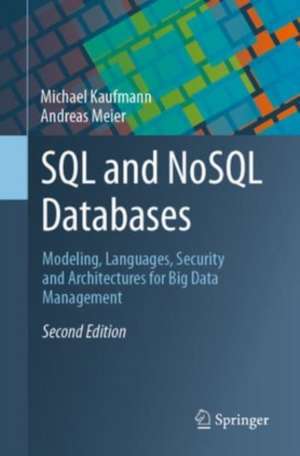SQL and NoSQL Databases: Modeling, Languages, Security and Architectures for Big Data Management
Autor Michael Kaufmann, Andreas Meieren Limba Engleză Paperback – 30 iun 2023
In the first five chapters, the authors analyze in detail the management, modeling, languages, security, and architecture of relational databases, graph databases, and document databases. Moreover, an overview of other SQL- and NoSQL-based database approaches is provided. In addition to classic concepts such as the entity and relationship model and its mapping in SQL database schemas, query languages or transaction management, other aspects for NoSQL databases such as non-relational data models, document and graph query languages (MQL, Cypher), the Map/Reduce procedure, distribution options (sharding, replication) or the CAP theorem (Consistency, Availability, Partition Tolerance) are explained.
This 2nd English edition offers a new in-depth introduction to document databases with a method for modeling document structures, an overview of the document-oriented MongoDB query language MQL as well as security and architecture aspects. The topic of database security is newly introduced as a separate chapter and analyzed in detail with regard to data protection, integrity, and transactions. Texts on data management, database programming, and data warehousing and data lakes have been updated. In addition, the book now explains the concepts of JSON, JSON schema, BSON, index-free neighborhood, cloud databases, search engines and time series databases.
The book includes more than 100 tables, examples and illustrations, and each chapter offers a list of resources for further reading. It conveys an in-depth comparison of relational and non-relational approaches and shows how to undertake development for big data applications. This way, it benefits students and practitioners working across the broad field of data science and applied information technology.
Preț: 345.26 lei
Preț vechi: 431.57 lei
-20% Nou
Puncte Express: 518
Preț estimativ în valută:
66.07€ • 68.17$ • 55.92£
66.07€ • 68.17$ • 55.92£
Carte disponibilă
Livrare economică 11-25 februarie
Livrare express 25-31 ianuarie pentru 28.43 lei
Preluare comenzi: 021 569.72.76
Specificații
ISBN-13: 9783031279072
ISBN-10: 3031279077
Pagini: 254
Ilustrații: XIV, 254 p. 110 illus., 109 illus. in color.
Dimensiuni: 155 x 235 x 19 mm
Greutate: 0.38 kg
Ediția:2nd ed. 2023
Editura: Springer Nature Switzerland
Colecția Springer
Locul publicării:Cham, Switzerland
ISBN-10: 3031279077
Pagini: 254
Ilustrații: XIV, 254 p. 110 illus., 109 illus. in color.
Dimensiuni: 155 x 235 x 19 mm
Greutate: 0.38 kg
Ediția:2nd ed. 2023
Editura: Springer Nature Switzerland
Colecția Springer
Locul publicării:Cham, Switzerland
Cuprins
- 1. Database Management. - 2. Database Modeling. - 3. Database Languages. - 4. Database Security. - 5. System Architecture. - 6. Post-relational Databases. - 7. NoSQL Databases.
Notă biografică
Michael Kaufmann is a professor at the Lucerne University of Applied Sciences and Arts. He teaches database systems and researches technologies for intelligent data management. Michael studied computer science, law and psychology at the University of Fribourg. He worked at PostFinance as a data warehouse power user in enterprise development, later at Mobiliar Insurance as a data architect in enterprise architecture and as a business analyst at FIVE Informatik AG. Parallel to his industrial activities, he earned a doctorate in computer science on the topic of inductive fuzzy classification in marketing analytics. Subsequently, he first taught at the Kalaidos University of Applied Sciences Zurich before moving to the Lucerne School of Engineering & Architecture. Since 2016, he has been working at the Lucerne School of Computer Science.
Andreas Meier is a former member of the Faculty of Economics and Social Science and was a professor of Information Technology at the University of Fribourg. He specializes in electronic business, electronic government, and information management. He is member of the GI (Gesellschaft für Informatik), IEEE Computer Society, and ACM. After studying music in Vienna, he graduated with a degree in mathematics at the Federal Institute of Technology (ETH) in Zurich, studied his doctorate, and qualified as a university lecture at the Institute of Computer Science. He was a systems engineer at the IBM research lab in San José, California, director of an international bank, and a member of the executive board of an insurance company.
Textul de pe ultima copertă
This textbook offers a comprehensive introduction to relational (SQL) and non-relational (NoSQL) databases. The authors thoroughly review the current state of database tools and techniques and examine upcoming innovations.
In the first five chapters, the authors analyze in detail the management, modeling, languages, security, and architecture of relational databases, graph databases, and document databases. Moreover, an overview of other SQL- and NoSQL-based database approaches is provided. In addition to classic concepts such as the entity and relationship model and its mapping in SQL database schemas, query languages or transaction management, other aspects for NoSQL databases such as non-relational data models, document and graph query languages (MQL, Cypher), the Map/Reduce procedure, distribution options (sharding, replication) or the CAP theorem (Consistency, Availability, Partition Tolerance) are explained.
This 2nd English edition offers a new in-depth introduction to document databases with a method for modeling document structures, an overview of the document-oriented MongoDB query language MQL as well as security and architecture aspects. The topic of database security is newly introduced as a separate chapter and analyzed in detail with regard to data protection, integrity, and transactions. Texts on data management, database programming, and data warehousing and data lakes have been updated. In addition, the book now explains the concepts of JSON, JSON schema, BSON, index-free neighborhood, cloud databases, search engines and time series databases.
The book includes more than 100 tables, examples and illustrations, and each chapter offers a list of resources for further reading. It conveys an in-depth comparison of relational and non-relational approaches and shows how to undertake development for big data applications. This way, it benefits students and practitioners working across the broad field of data science and applied information technology.
Caracteristici
Explores relational (SQL) and non-relational (NoSQL) databases Covers database management, modeling, languages, security, architecture and more Extensively illustrated with more than 100 tables, examples and illustrations
























